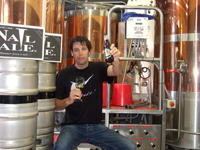
John Stallwood on craft beer
Name:John Stallwood
Title: Owner/brewer Nail Brewing (WA)
Annual output: >30,000L
Web: www.nailbrewing.com
This is a good question and a hard one. I don’t have the answer and I’m not sure if there is an all-encompassing one, but this is my thinking.
The difference between big and small breweries needs to be explained to untangle the difference between craft beer and microbreweries. Microbreweries brew craft beer, but bigger breweries can too (but often don’t). Microbreweries and big breweries are differentiated by their volumes only. The approach of big breweries and small breweries comes down to volume and economics. Big breweries sell large volumes by good marketing, distribution, accounting and advanced brewing techniques, but they brew styles designed in sell in large volumes: beers that will offend no-one, usually of the style lager.
The world’s biggest breweries brew perfect commercial mainstream beers. Fosters and Lion Nathan are masters of brewing perfect commercial mainstream beers. They are made not to offend the palette and are well marketed for the mass, with great brew consistency and minimal beer faults.
If a microbrewery brewed this type of beer, they are in the wrong business and would be out of business. You cannot compete with the big breweries on these beers. When I consult, I have been asked if I can brew a beer like Corona. Of course you can, but not with consistency and economic efficiency of commercial main stream beer. But more to the point why would a microbrewery want to?
Microbreweries brew beers on a bad economic scale and with distinct flavours that can offend people that don’t know beer comes in styles and flavour. Microbreweries have small brew lengths and annual productions. Microbreweries brew craft beer. Big breweries don’t.
Craft beer is a term that relates to brewing technique and beer style. It is not volume related..
Craft beer takes no shortcuts and pays more for different and quality ingredients. Craft beers use traditional methods of brewing without adjuncts such as rice and corn used for the purpose of simply cutting costs, reducing flavour in already low-flavoured beer or brewing convenience (though craft beer can contain other grains and adjunct sugars).
So essentially I think, craft beer is a beer that usually smaller breweries choose to brew for flavour related to their local beer drinkers with their own unique flavours. Craft beer is brewed for unique flavour rather than mass appeal. A good craft beer stands out with more unique flavour strengths where a good commercial mainstream beer stands out from unique marketing.
At a Western Australian Brewers Association meeting a few years back we decided to move away from calling our beers “boutique” a term that has been commonly used by many brewers to describe their slightly more niche offerings. We decided to follow the path taken in the UK, Canada, US and New Zealand and refer to our beer as “craft beer”.
Microbreweries brew craft beers, big breweries brew commercial, mainstream beers and I guess there is a clear difference between them. It is when a microbrewery grows and becomes a bigger brewery and the beer flavour slowly lightens that the definition of craft beer becomes even blurrier.
The good thing about good craft beer besides it uniqueness, is that it is usually locally owned by a group that puts the money back into our country. The bad thing about a good craft beer is that they often slowly move towards the less offensive commercial mainstream trait and also tend to end up being taken over.
Full mash home brewers brew craft beers and are the core of of the movement. I don’t think they realise they need to help out their local microbreweries to keep the craft beer growing.
And, incidentally, the biggest killer to microbreweries is excise. The biggest killer to craft beer is lack of beer style education.




